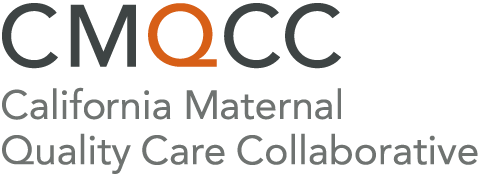Obstetric hemorrhage is one of the leading causes of severe maternal morbidity and mortality in California. The California Pregnancy-Associated Mortality Review has repeatedly identified hemorrhage as one of the causes of potentially preventable maternal mortality and morbidity, a life-threatening complication during pregnancy. CMQCC has been working with hospitals to standardize care and improve their readiness, recognition, response and reporting of obstetric hemorrhage.
To help healthcare providers implement the latest evidence and best practices, CMQCC recently completed its second revision of the Improving Health Care Response to Obstetric Hemorrhage Toolkit. Formerly published in 2010 and 2015 together with the California Department of Public Health, this is the second update to the Hemorrhage Toolkit to incorporate the latest evidence and best practices.
Key changes in the revised toolkit include:
- Expanded guidance on obstetric hemorrhage risk factor assessment to include parameters for continued re-evaluation of risk and an updated Obstetric Hemorrhage Risk Screen Table
- Increased emphasis on the importance of assessment for concealed hemorrhage
- Updated medication protocols and recommendations on the use of tranexamic acid (TXA) as an adjunctive therapy
-
Multiple new chapters, including:
- Management of Iron Deficiency Anemia
- Secondary Obstetric Hemorrhage and Readmission
- Implementing and Sustaining Maternal Quality, Safety and Performance Improvement for Obstetric Hemorrhage
Throughout the revised toolkit, we have included resources to address inequities in quality of care and shared the voices of women and their lived experiences with hemorrhage. Management guidelines are in alignment with the 2021 Joint Commission Standards for Maternal Safety and National Partnership for Maternal Safety Hemorrhage Bundle.
In addition to our toolkit, CMQCC has launched statewide outreach collaboratives focused on implementation of patient safety bundles for hemorrhage. Severe maternal morbidity (SMM) among women with hemorrhage was reduced by 20.8% between 2014 – 2016 among hospitals participating in the California Partnership for Maternal Safety (CPMS) collaborative, compared with only a 1.2 percent reduction for non-participating hospitals. Hospitals that had also participated in previous CMQCC hemorrhage collaboratives reported an even larger reduction in SMM: 28.6%.
Improving Health Care Response to Obstetric Hemorrhage Toolkit, Version 3.0
The Improving Health Care Response to Obstetric Hemorrhage Toolkit was developed by the Obstetric Hemorrhage Task Force to assist obstetric providers, clinical staff, hospitals and healthcare organizations with timely recognition and response to hemorrhage. Obstetric hemorrhage remains a leading and preventable cause of maternal mortality and severe maternal morbidity, a life-threatening complication during pregnancy.
Download Improving Health Care Response to Obstetric Hemorrhage Toolkit, Version 3.0
Beginning April 30, toolkits and related resources on our website will require a CMQCC Account login. First, locate the toolkit/resource on the website. Click on the toolkit/resource, and you will be prompted to log in or create an account. After you’ve logged in, you’ll automatically see an option to complete the download. Questions or need help? Email us at info@cmqcc.org. (Note: This is a different email than for MDC support!)
- Errata: Table Chart Appendix C and Flow Chart Appendix D erroneously depicted that methylergonovine is given in Stage 1 as a standard practice. The intention is to perform the interventions listed in Stage 1, but not hesitate to MOVE ON to a 2nd level uterotonic if there is no response to Stage 1 measures. Methylergonovine would be the preferred choice if the patient is not hypertensive due to the lower cost and relative lack of side effects, however, carboprost is acceptable for patients that do not have a history of asthma. Misoprostol should be reserved for patients that have contraindications to the other two medications. Both appendices have been edited to reflect this workflow.
- Informational Webinar
- Webinar Slideset
Individual sections of the toolkit are also available for download:
- Appendix A: Classification of Evidence Grading
- Appendix B: Obstetric Hemorrhage Care Guidelines: Checklist Format
- Appendix C: Obstetric Hemorrhage Care Guidelines: Table Format
- Appendix D: Obstetric Hemorrhage Care Guidelines: Flowchart Format
- Appendix E: Checklist: Carts, Kits and Trays
- Appendix F: Simulations and Drills: Guidelines for Simulation Scenario Development
- Appendix G: Simulations and Drills Sample Scenarios
- Appendix H: Checklist for Patients Who May Decline the Use of Blood Products
- Appendix I: Discharge Planning for Women with Hemorrhage During the Birth Hospital Stay
- Appendix J: Sample Obstetric Outpatient Intravenous Iron Infusion
- Appendix K: Obstetric Hemorrhage Risk Factor Assessment Screen
- Appendix L: Hemorrhage ED Visit Stop Sign
- Appendix L: Hemorrhage ED Visit Stop Sign, Spanish Language
- Appendix M: Sample QBL Worksheet
- Appendix N: Techniques for Quantitative Assessment of Blood Loss (QBL)
- Appendix O: Terms and Techniques for Describing Blood Loss
- Appendix P: Sample Paper Calculators for Quantifying Blood Loss
- Appendix Q: Sample Schematic: Preadmission Planning for Women Undergoing Scheduled Cesarean Section
- Appendix R: Medications for Postpartum Hemorrhage
- Appendix S: Sample Massive Transfusion Policy – Torrance
- Appendix T: Sample Massive Transfusion Procedure Miller Children’s and Women’s Hospital
- Appendix U: Sample Code Crimson Postpartum Hemorrhage Management
- Appendix V: A Guide to Recognizing Acute Stress Disorder in Postpartum Women in the Hospital Setting
- Appendix W: Patient and Family Support Checklist for Postpartum Hemorrhage
- Appendix X: Life After Postpartum Hemorrhage
- Appendix Y: Resources for Postpartum Hemorrhage Survivors
- Appendix Z: Sample Patient Summary Form: Obstetric Hemorrhage Event
- Appendix AA: Sample Script: Provider - Patient Postpartum Hemorrhage Post-Event Discussion
- Appendix BB: FAQ What do patients need to know?
- Appendix CC: Sample Hemorrhage Rapid Debrief Form
- Appendix DD: Sample Labor and Delivery Event Debrief Form
- Appendix EE: Alert on Blood Transfusion Procedure Coding
- Appendix FF: Obstetric Hemorrhage Sample Order Set Staged
Funding Acknowledgement
This toolkit is an update to the Improving Health Care Response to Obstetric Hemorrhage Toolkit, V2.0, funded by the California Department of Public Health in 2015 and supported by Title V funds.
